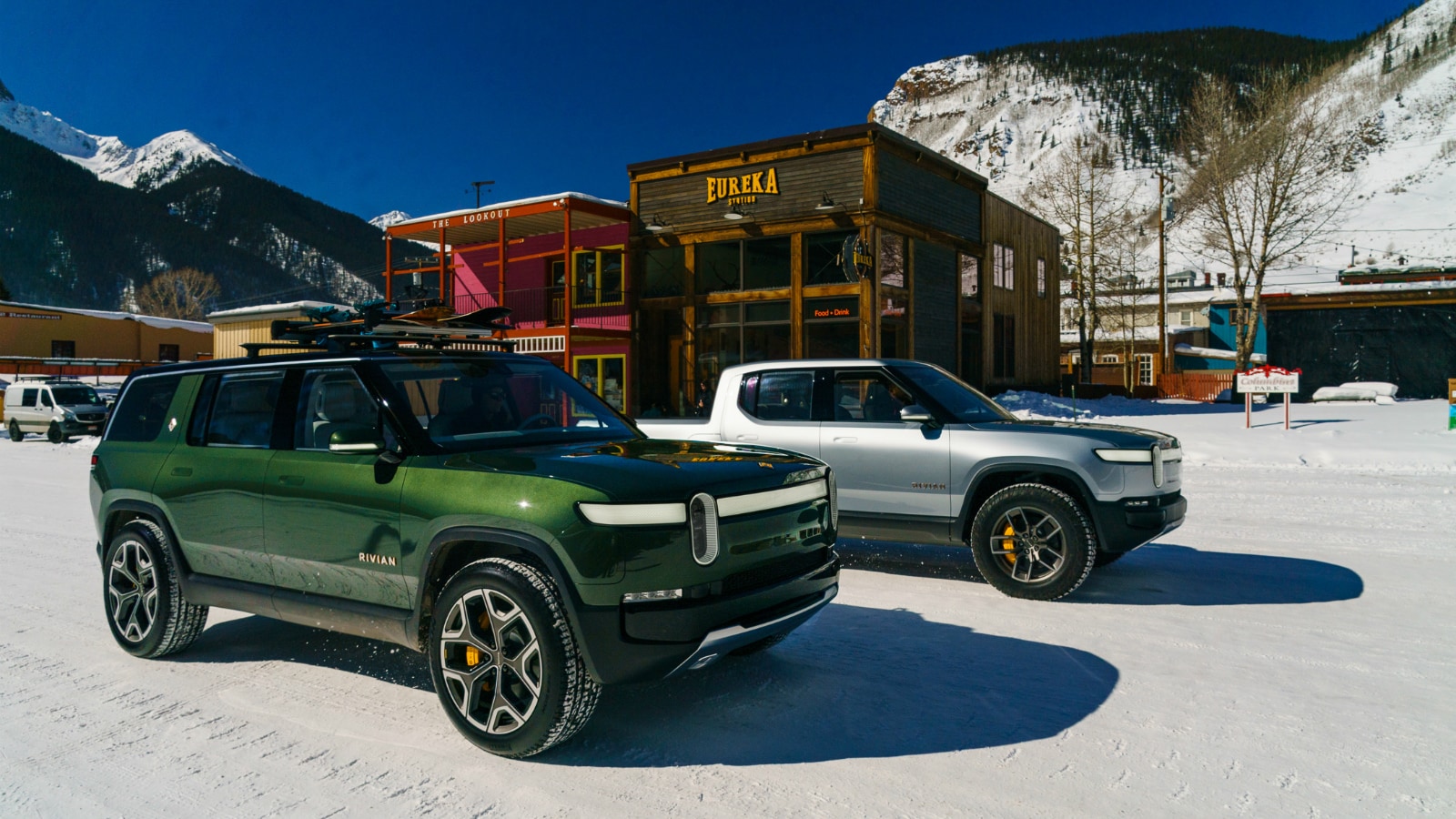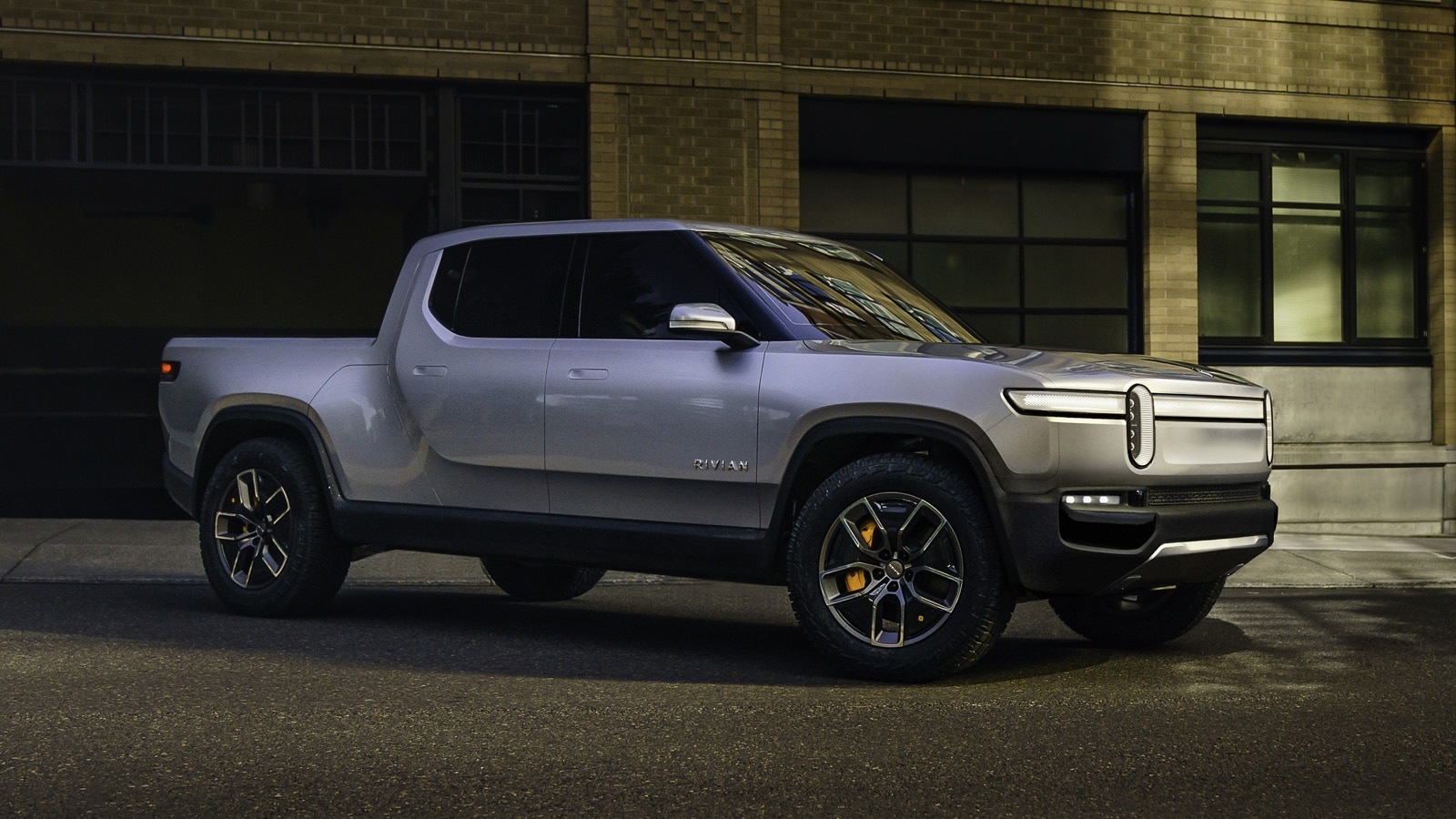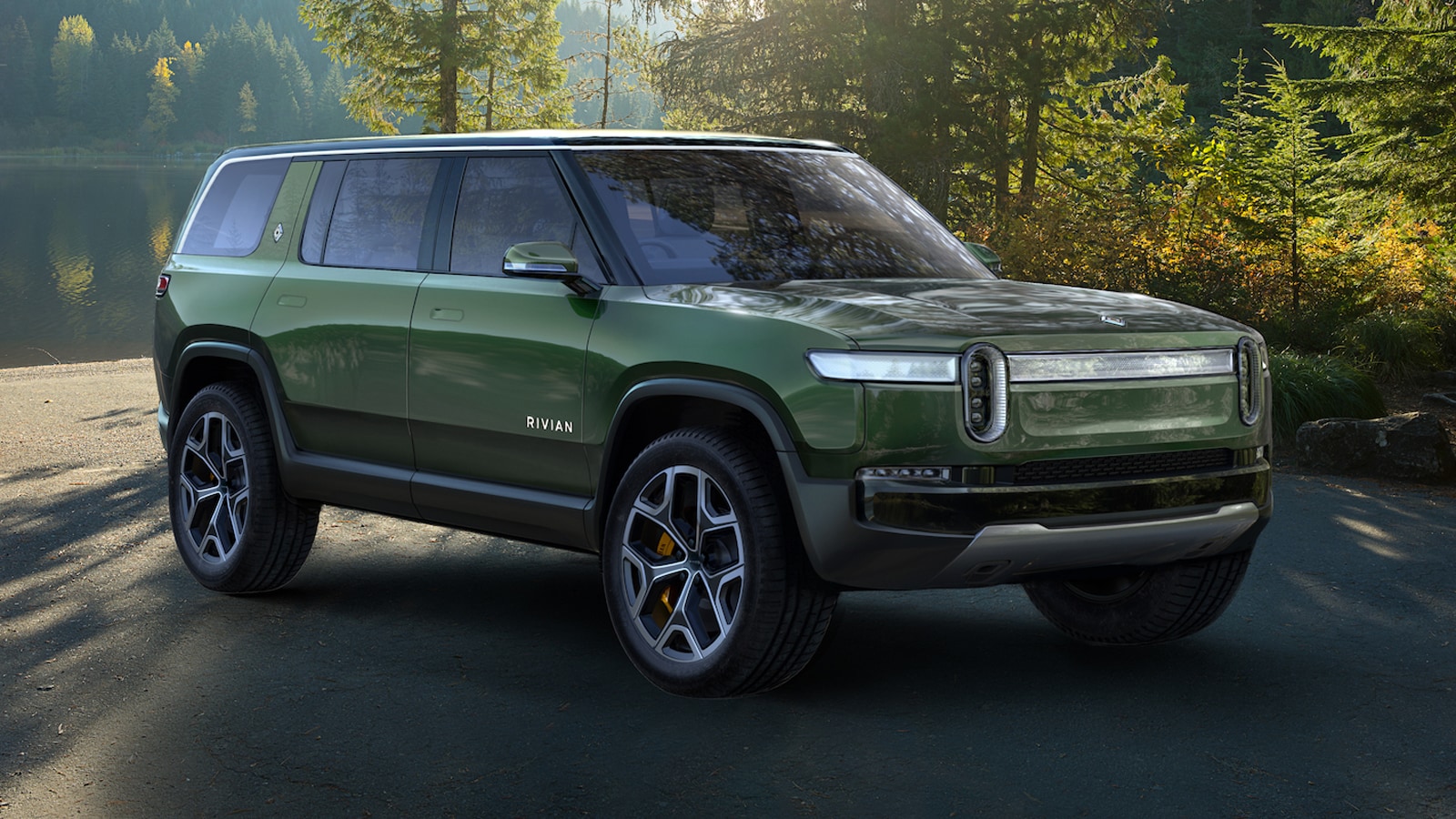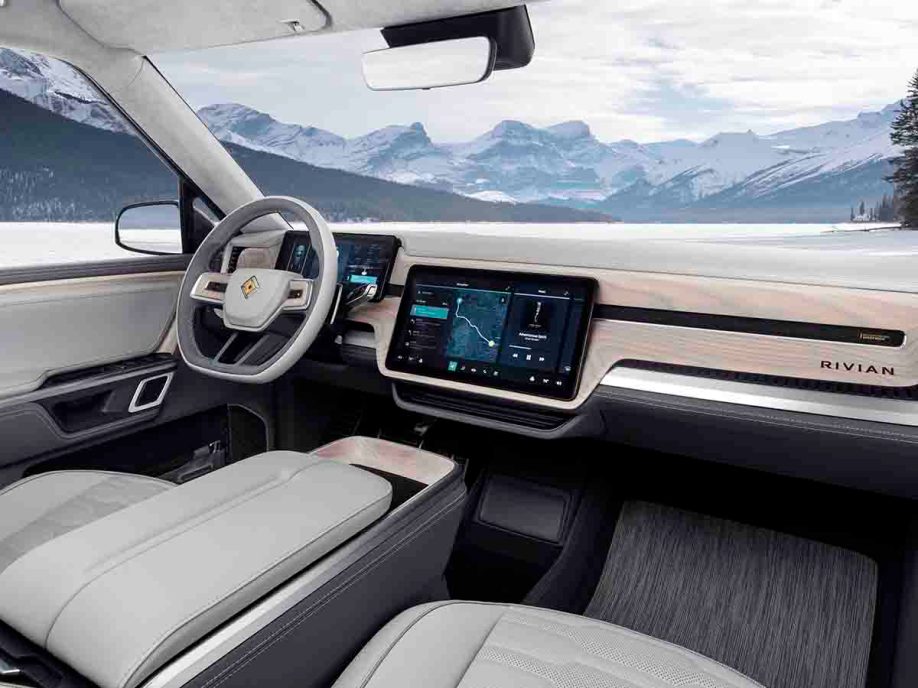Rivian is an American electric car company that seeks to combine the growing popularity of trucks and SUVs with electric powertrains. The first results of Rivian’s efforts are the R1S sport-utility and the R1T pickup truck.
- Rivian is an American electric vehicle manufacturer with a pickup truck and SUV set to go on sale next year
- Expect both vehicles to have an entry-level driving range of 230 miles and up to 410 miles
- Starting price will be around $70,000 and the truck, the R1T, will have a max towing capacity of 11,000 lb.
- The truck and SUV employ “skateboard” chassis
Rivian EVs have the rugged, square-shaped exterior design of a traditional truck or SUV. Yet, underneath the boxy bodywork are four electric motors, an advanced all-wheel drive system, and three available battery packs. All components nestle into a compact “skateboard” chassis. Depending on which model and battery pack you choose, your driving range per charge stretch from 230 to 410 miles.
The Rivian “Skateboard”

The electric heart of the Rivian R1S and R1T is the “skateboard” chassis. It houses the lithium-ion battery pack, which sits low and in the center of each vehicle. This low center of gravity aids in the truck’s ride and handling balance, with no loss of all-terrain capability. In fact, both trucks are said to be capable of wading through up to 39-inches of water. A skid-plate is also installed, to protect against errant rocks and other chassis-crunching obstacles.
The skateboard chassis also supports four electric motors, with one mounted at each wheel. This means AWD is standard across the entire Rivian range. Control of power and torque at each wheel is said to be extremely precise, according to Rivian, thanks to the onboard electronics that can carefully measure which wheels have the most available grip.
Keeping the ride balanced and under control is an air suspension that raises and lowers the vehicle, depending on drive mode. These will likely include settings along the lines of Comfort, Off-Road, and Sport mode.
Plenty of power on tap
Why bother with Sport-anything when talking about a pickup and SUV? Well, that’s because the R1S and R1T have anywhere from 400 horsepower, to in excess of 750 hp in range-topping models fitted with the largest available battery pack. Acceleration to 60 mph ranges from 3.0 seconds to 4.9 seconds in entry-level models. That’s sports car-like quick, and a match for anything from the likes of Tesla, or traditional truck-focused luxury brands like Land Rover/Range Rover.
This highly-flexible and modular chassis is one of the primary reasons Ford Motor Company invested $500-million dollars in Rivian. Not only can the platform accommodate a variety of battery packs, but it’s also home to control modules that control everything from vehicle stability and battery management to navigation and monitoring the drive systems.
Rivian has also devised an extremely efficient way to cool the batteries along the axis of the vehicle, using “chill plates” between each row of battery cells. This translates to a pack that provides more energy and is less complicated when it comes to maintaining peak operating temperatures.
Rivian driving range
When it arrives next year, the R1S and R1T will have a starting price of roughly $70,000 (before factoring in any EV tax incentives). Pricing divides into three tiers, with each corresponding to a different size battery pack. The entry-level Rivian truck and SUV come equipped with a 105 kWh battery that provides a total driving range of 230 miles. The mid-range option is a 135 kWh pack, which nudges range to 310 miles.
Last on the pricing ladder is the 180 kWh battery. Coupled with those four electric motors, this powertrain delivers around 750 horsepower to all four wheels and can hustle the R1S and R1T from zero to 60 mph in only 3.0 seconds. More importantly, total range zooms upward to 400 miles in the R1T truck, and 410 miles in the R1S sport-utility.
Fast-charging provides either model with about 200 miles of range in as little as 30 minutes. We’ll see how the range – particularly the 180 kWh model – fares in more routine Level 1 (110-volt) and Level 2 (240-volt) charge cycles.
Traditional truck looks and capability
The Rivian lineup looks a lot like something a kid might draw when asked to sketch a truck. Those Duplo-like lines aren’t by accident, or due to a lack of creativity. Jeff Hammoud, Rivian’s vice president of design, spent the bulk of his working career at Jeep before jumping ship to Rivian.
So, if you like the square-shape of a Wrangler or Grand Cherokee, chances are you’ll appreciate the upright lines of the R1S and R1T.
Hammoud told us his design inspiration came from SUVs dating to the mid-1990s. Many of these were truck-based models, with body-on-frame platforms and boxier exteriors. He wants to combine the cutting-edge engineering of the Rivian with a shape that is instantly recognizable, even if you cover the vehicle with a dustsheet.
Today, with the trend in SUVs leaning towards more car-like (and in some cases, even coupe-like) design, Rivian set out to create vehicles that are unashamedly truck-like in terms of style and dimensions.
Full-size dimensions
At 215 inches in length, the R1T is about the same size as current full-size trucks like the Ford F-150, Chevrolet Silverado, and Ram 1500. Those models have a much wider array of cab and cargo bed lengths, however. As for the R1S, it’s is about two feet shorter, and measures in at 198.4 inches in total length – about the same size as a 2019 Ford Explorer.
The approach and departure angles for either Rivian is 34 degrees front, 30 degrees rear. For comparison, the all-terrain-superhero Jeep Wrangler has approach and departure angles of 44 degrees and 37 degrees. If towing is more your thing, it’s worth noting the R1T has a maximum towing capacity of 11,000 pounds, while the R1S maxes out at 7,700 pounds.
Surprise and delight touches
It’s not often that we’ll geek-out over a cargo area. Except the Rivian R1T sports an especially cool feature known simply as the “Gear Tunnel.” This hidden storage compartment is located directly behind the 5-passenger cabin and the pickup bed. Accessed via panels located on either side of the truck, these fold down to allow uninterrupted access to 12.3 cubic feet of secretive space.
Better still, each access panel can hold up to 300 pounds. This allows full-grown adults to use them to reach roof-mounted cargo rails. They also serve as a seat to change muddy hiking boots. Beneath each panel’s removable cushion, you’ll find a handy first-aid kit.
Want even more room? Thanks to being electric, the R1S and R1T don’t have an engine taking up space in the nose. Instead, you’ll find 11.6 cubic feet of room. This is particularly convenient in the R1S SUV when all three throws of seating are occupied. Rather than having to choose between hauling a full complement of people, or jettisoning one or two humans to make room for shopping bags and luggage, this frunk can swallow extra cargo without needing to fold seats down to expand interior cargo room.
High tech cabin

Take a look inside either Rivian and you’ll see this is not your typical truck or SUV cabin. For starters, the dashboard features two large screens with no visible buttons or dials. That can be great in terms of style but, in some cases, a touch-screen-intensive format has proven to be maddening in high-end vehicles. We’ll wait to see how intuitive Rivian’s system is before heaping praise, or condemnation, upon it.
At the very least, the center-mounted 15.6-inch touch screen for the infotainment system is big enough for large ‘virtual buttons’ that are easy to locate without taking your eyes off the road. Passengers in the second row can access a touch-screen interface, this time measuring 6.8-inches in width.
Rivian safety
When it comes to safety, there are a total of eight airbags in the R1S and R1T. Rivian intends to earn Top Safety Pick+ rating (the highest possible score) from the Insurance Institute for Highway Safety. It also seeks a five-star score (again, the best result possible) from the National Highway Traffic and Safety Administration.
A company representative told us that exact safety specs are still in process. It seems likely both models will boast standard features like automatic emergency braking, lane-keep assist, low-speed emergency braking, a rearview camera, blind-spot monitoring, and rear cross-traffic alert. More details will come closer to the official on-sale date.
Self-driving tech
The R1S and R1T bristle with sensors, including cameras, radar, LiDAR, and ultrasonic sensors. Upon launch, “Level 3 autonomy-capable hardware” will be available on every Rivian vehicle. Keep in mind, the specifics of this self-drive system remain to be determined. Over-the-air updates could allow Rivian to launch with a simpler system, one that requires more input and attention from the human behind the wheel.












